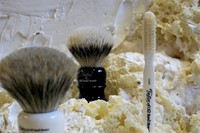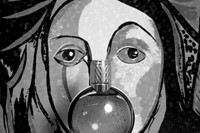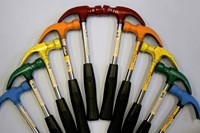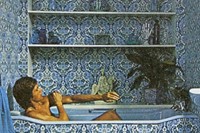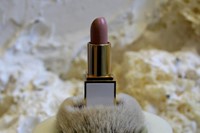Artist Julie Verhoeven gives her spin on a selection of women's and men's beauty and grooming products
"If You're Happy And You Know It" (clap your hands) is the repetitive song we remember from our school days. It is this popular song which was one of the starting points for artist Julie Verhoeven's glorious beauty film for AnOther, created in collaboration with Neil Emery. For this AnOther Exclusive, Verhoeven presents a varied selection of beauty and grooming products, for both men and women, from vibrant lipsticks and luxurious face creams to perfumes and the all-important tools. Placing them in unusual contexts – natural sea sponge and DIY church glass windows – and interspersing them with intriguing, unexpected objects – a pineapple, a corkscrew and a padded rainbow – Verhoeven gives a new spin on the world of beauty and grooming.
The film is awash with Verhoevenisms. Since graduating from Medway College in 1987, and working as a designer, illustrator and artist, she has established key trademarks. As well as her iconic dreamlike and often provocative illustrations, she has become renowned for her vibrant use of colour, a surrealist perspective, mixing old with the new and for finding beauty in the strange and unusual. If You Are Happy And You Know It features a succession of carefully considered still lives. A landscape of shaving accoutrements from Taylor of Old Bond Street, eye-popping M.A.C. eyeshadows in a plastic dustpan and a sundial of Estée Lauder Lauder lipsticks and Dior nail varnishes. "I wanted to treat the products as inanimate objects, devoid of function, to avoid beauty cliched product shots", Verhoeven says.
In the film, she references many of the keystones of her youth. Particularly interesting as beauty and grooming marks the move into adulthood. The film is set to the soundtrack of Seasons in the Sun by Terry Jacks, a song that a had a big influence on Verhoeven as a child. "It's very cheesy and sentimental and had mass appeal at the time but was also very sad. It upset me as a young child because it made me think about death." She also looked to the graphic and print work of American artist Jim Dine, "I first discovered him as a teenager. I have always loved Pop Art and he would often crop up in overviews of the period. Although he is considered more of a Neo-Dadaist which greatly appealed to me, with his repetitive use of imagery, such as the artist's palette, heart, tie and hammer." She also considered British painter Patrick Hughes' rainbow series of prints from the 1970s, the weird unsettling assemblages of Lucas Samaras and the children's magazine, Bonnie. "The lead character Roxy and her rainbow poncho in the comic strip The End of the Raindow had a lasting impression. Like any Verhoeven work, their is a dark undertone, " I sort of hate this sense of nostalgia. There's certainly an angry, aggressive undercurrent. I also hate hippy, drippy, triply, New Age baloney and am kind of having a soft poke at that too."
Text by Laura Bradley

